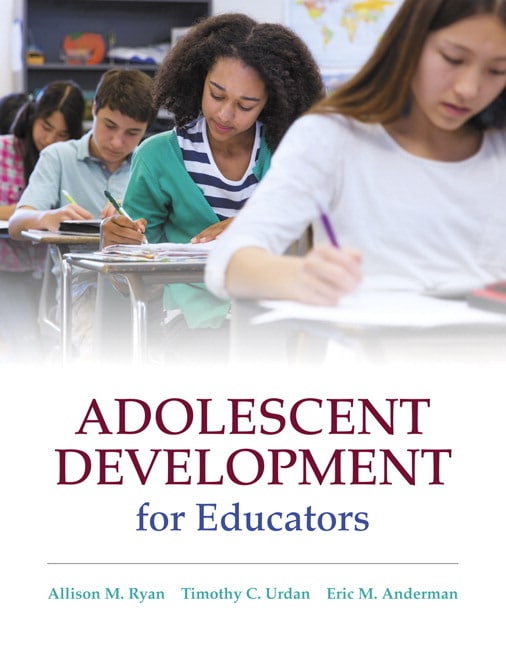
Adolescent Development for Educators, 1st edition
- Allison M Ryan
- , Timothy C. Urdan
- , Eric M. Anderman

- Study simpler and faster
Use flashcards and other study tools in your eTextbook
- Watch and learn
Videos & animations bring concepts to life
- Listen on the go
Learn how you like with full eTextbook audio
- Find it fast
Quickly navigate your eTextbook with search
- Stay organized
Access all your eTextbooks in one place
BRIEF TABLE OF CONTENTS
1. Introduction to Adolescence
2. Physical Development
3. Cognitive and Intellectual Development
4. Social and Moral Development
5. Identity and Self-Perceptions
6. Families
7. Technology and Media
8. Peers
9. Motivation, Classrooms and Schools
10. Sexuality and Romantic Relationships
11. Mental Health, Coping Strategies, and Problems
12. Moving into Adulthood
DETAILED TABLE OF CONTENTS
1. Introduction to Adolescence
Introduction
Defining Adolescence
The Lives of Adolescents
Frameworks for Conceptualizing Adolescent Development
Structure of the Book
2. Physical Development
Introduction
Physiological Development in Puberty
Development of the Brain During Adolescence
How Physical Development Affects Social And Cognitive Change
Body Image and Eating Disorders
Physical Health and Well-Being
Adolescent Health and School Health Services
Recommendations for Educators
3. Cognitive and Intellectual Development
Introduction
Piaget’s Theory of Cognitive Development: Implications For Adolescents
Vygotsky’s Theory of Cognitive Development
Integrating Piaget and Vygotsky
Adolescent Cognitive Development in the 21st Century
Memory
Intelligence
Metacognition
Limitations of Adolescents’ Cognitive Abilities
Recommendations for Educators
4. Social and Moral Development
Introduction
Moral Development During
Perspective Taking
Religiosity During Adolescence
Volunteering and Service Learning
Academic Cheating
Recommendations for Educators
5. Identity and Self-Perceptions
Introduction
Theories, Conceptualizations, and Definitions of Identity
Gender Identity
Ethnic and Cultural Identity
Recommendations for Educators
6. Families
Introduction
Changing Circumstances of Adolescents and Families In Society
The Family System During Adolescence
Parenting Styles
Attachment and Autonomy
Conflict with Parents
Parental Involvement in Adolescent Learning
Recommendations for Educators
7. Technology and Media
Introduction
Technology and Media Use
Media and Adolescent Development
Media Effects
Social Media
Recommendations for Educators
8. Peers
Introduction
Friends
Peer Groups
Crowds
Popularity
Bullying, Aggression and Victimization
Supporting Students’ Peer Relationships at School
Recommendations for Educators
9. Motivation, Classrooms and Schools
Introduction
Motivation
Classrooms
Socioeconomic Status, Ethnicity, and Schooling
Recommendations for Educators
10. Sexuality and Romantic Relationships
Introduction
What Is Healthy Sexual Development?
Rates of Sexual Activity
Romantic Relationships in Adolescence
Where Adolescents Get Their Information About Sex
Problems Associated with Adolescent Sexual Behavior
Recommendations for Educators
11. Mental Health, Coping Strategies, and Problems
Introduction
Internalizing Disorders Common Among Adolescents
Externalizing Disorders Most Common During Adolescence
Substance Use Abuse Among Adolescents
Recommendations for Educators
12. Moving into Adulthood
Introduction
Emerging Adulthood
Transitions into College
Transitions into the Workforce
Transitions into the Military
Recommendations for Educators